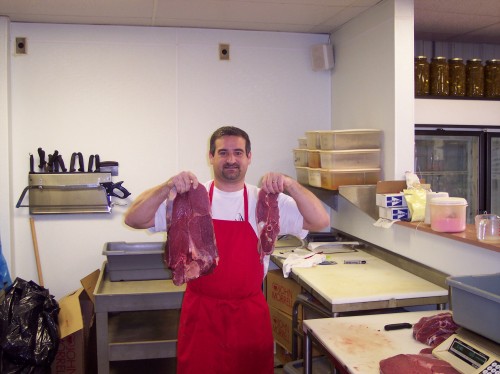
Fed policies ruin business opportunities, Scalise says
October 23, 2012
Audrey Ougel Callahan
October 26, 2012Hunting season is big for Ken Blanchard. While area outdoorsmen are preparing guns, bows, stands and other equipment in the field, Blanchard’s seasonal tools between now and the end of January include knives, saws and industrial grinders. It’s all part of being a wild game butcher that hunters rely on every year.
Blanchard grew up a third-generation butcher in a Thibodaux family business, worked as a meat cutter in retail grocery settings, then opened his own shop in Raceland to keep his trade skills pure and focus on wild game processing.
“Meat cutters today in grocery stores have everything delivered to them in boxes,” Blanchard said. “You could probably throw a side of beef in front of them and they wouldn’t know what to do, because they have never been exposed to hanging beef.”
This butcher said his skill is also part art, because he is able to take a raw form and slice it into steaks, ribs and roasts, or process ground meat and seasoned sausage.
Blanchard is specifically known for his varieties of deer and pork blend sausages – many recipes he has individually created. They are popular with customers, but unavailable in retail settings.
“We usually take his sausage on trips to places we hunt in Colorado and Arkansas, and people always ask where we got it because it is so good,” 12-year customer Grady Giliano said of Blanchard’s products. “[Blanchard] always does excellent work.”
“My [speciality] is deer,” the butcher said. “I take pride in that most of my flavors are ones that are either handed down to me or I customize them. My latest seasoning is one where I take some roasted red pepper, some bell pepper and add that to some seasoning. It’s pretty good.
“I don’t just look on the Internet or used packaged seasons,” Blanchard continued. “Anybody can do that. I come up with the recipes myself.” Blanchard’s most popular flavor is Cajun seasoned sausage.
Personal orders and cuts are two advantages independent butchers offer over chain meat markets. “If you go to Wal Mart and want an inch-and-a-half thick cut I don’t know that you can get that,” Blanchard said. “If you don’t know how to cook it, they don’t know what to tell you.”
Blanchard said a skilled butcher is more than a meat slicer. The tradesman knows how various cuts need to be prepared, seasoned and made fit for human consumption.
During his time in business, Blanchard has processed various species of deer. He also services hunters that have brought in alligator, bear, duck, goose and buffalo. “I’ve even done nutria – one time,” he said.
Hunters are asked to bring meat in skinned and gutted. Blanchard tells them to make sure it is clean. otherwise any residue from impurities could end up marinating the meat and spoiling its flavor.
Blanchard recommends hunters wanting to make sure they get back their own meat from what they harvest should avoid large processors. Those businesses simply dump a day’s collection of meat together and package the bulk blend by weight. “They make one big batch of sausage,” Blanchard said. “You might have somebody that didn’t take good care of their deer having his meat mixed with somebody’s that did take good care of his deer,” he said.
The Raceland-based butcher said he processes each order individually, vacuum seals sausages, ground meat or steaks, then labels them by product and date packaged. He also smokes meat and makes deer jerky.
As a licensed meat processor, Blanchard is able to make cuts and products for direct customers, but cannot sell wild game products on a retail level. “I’m like a butcher for hire,” he said. “I used to have a sign in front of the store, but it only confused people. So I took it down.”
The cost of wild game processing varies depending on the amount of work required. Blanchard charges $60 to debone a deer. This includes gland and fat removal. Total time required is approximately 35 minutes.
During the first part of deer season, complete processing can be done within one work day. At the height of the season (late December), count on waiting a week to 12 days because of a backlog in orders filling his freezer and the variety of products ordered by any given customer.
Transforming boneless deer meat into vacuum packed sausage can be done for $2.30 a pound. Comparative prices in traditional grocery stores range from $3 to $6 a pound of processed beef or pork sausage.
“I’m not saying the meat in the grocery store is bad, but those roasts that started to look a little aged? That went into the sausage,” Blanchard said based on his experience in multiple business settings.
“With mine you know what you are getting,” Blanchard said. “Any pork I use with deer is fresh (to ensure moistness and quality). Straight deer is dry. So, for every pound of deer meat you bring in I’m going to put in pork.”
Some customers have requested beef brisket be mixed with deer for sausage. Cuts that Blanchard uses are also fresh and secured through wholesalers.
“I don’t mark up the pork or beef,” Blanchard said. “I make my money when I process it.”
This butcher cannot sell wild game to the general public, but has built a strong customer base across southern Louisiana. Work is constant during hunting season. So Blanchard dedicates time for his wife and two children during the remaining four months of the year. “I have to work Christmas and New Years, but I get the whole summer to enjoy the family,” he said.
According to the Louisiana Department of Wildlife and Fisheries, the state deer harvest totaled 133,000 during the 2011-2012 seasons.
Blanchard sees increases in hunting by what he processes. His first year in business he worked 400 deer. This season he is expecting more than 1,000. “I think people are realizing the benefits of eating deer,” he said. “They are not wormed or shot up with steroids. It is natural meat.”
Hunters are preparing for the height of their season. This wild game butcher, along with others in the trade, is preparing to process a harvest.
Ken Blanchard shows the comparison of a deer steak, left, to a buffalo steak. In addition to the surprising size comparison, regular hunters know, one three-ounce serving of deer meat contains 26 grams of protein.













